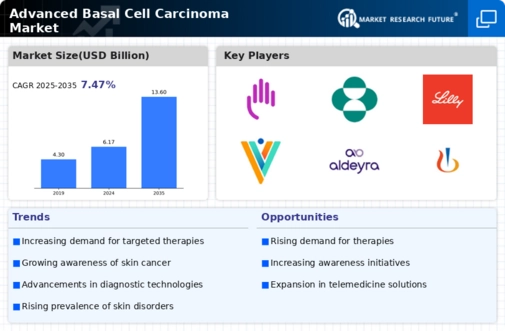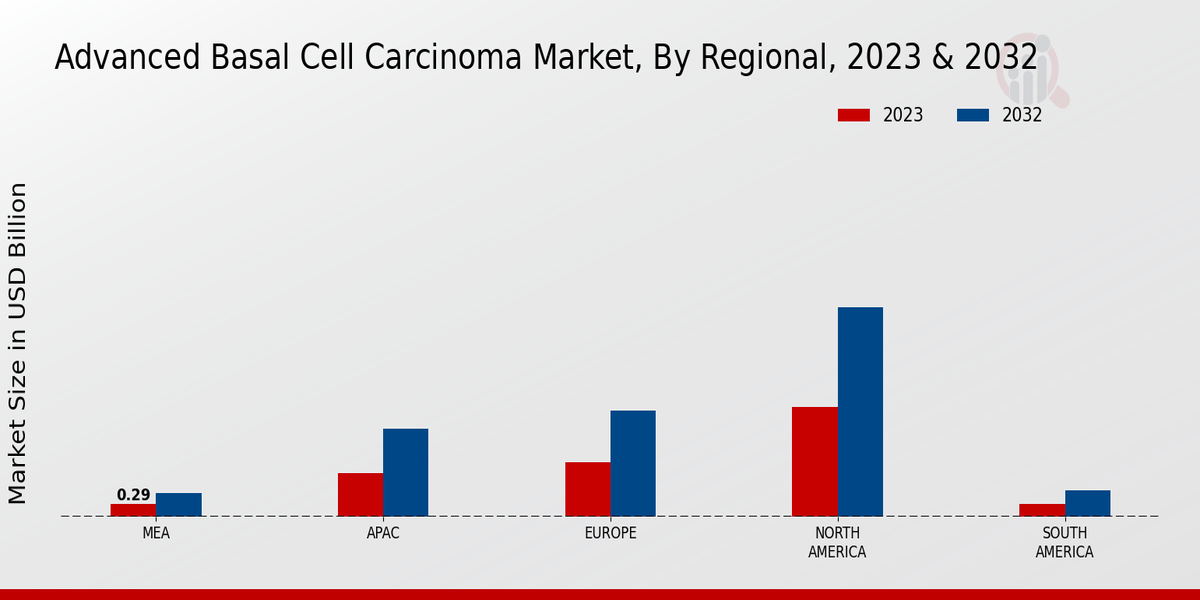Aging Population
The demographic shift towards an aging population is a critical driver of the Global Advanced Basal Cell Carcinoma Market Industry. Older adults are at a higher risk for developing skin cancers due to cumulative sun exposure and age-related skin changes. As the global population ages, the prevalence of basal cell carcinoma is expected to rise, necessitating increased healthcare resources and treatment options. This demographic trend not only influences market dynamics but also underscores the need for tailored treatment strategies for older patients. The growing demand for specialized care is likely to propel market expansion in the coming years.
Market Growth Projections
The Global Advanced Basal Cell Carcinoma Market Industry is projected to experience substantial growth over the next decade. With a market value of 6.17 USD Billion in 2024, it is expected to reach 13.6 USD Billion by 2035, reflecting a compound annual growth rate of 7.47% from 2025 to 2035. This growth trajectory suggests a robust demand for advanced treatment options and increased investment in research and development. The market dynamics are influenced by various factors, including technological advancements, demographic shifts, and regulatory support, all contributing to a favorable environment for market expansion.
Regulatory Support and Funding
Government initiatives and regulatory support are essential factors propelling the Global Advanced Basal Cell Carcinoma Market Industry. Increased funding for cancer research and development, along with favorable regulatory frameworks, encourages innovation in treatment options. Governments worldwide are prioritizing cancer care, leading to enhanced access to advanced therapies. This support is crucial for fostering an environment conducive to research and development, which may result in the introduction of novel therapies. As a result, the market is poised for growth, with stakeholders likely to benefit from these supportive measures.
Rising Incidence of Skin Cancer
The Global Advanced Basal Cell Carcinoma Market Industry is experiencing growth driven by the increasing incidence of skin cancers, particularly basal cell carcinoma. Factors such as prolonged sun exposure, environmental pollutants, and lifestyle choices contribute to this rise. In 2024, the market is projected to reach 6.17 USD Billion, reflecting heightened awareness and diagnosis rates. As more individuals seek treatment, the demand for advanced therapies and technologies is likely to escalate, indicating a robust market trajectory. This trend underscores the necessity for ongoing research and development in effective treatment modalities.
Increased Awareness and Education
Public awareness campaigns and educational initiatives regarding skin cancer are significantly influencing the Global Advanced Basal Cell Carcinoma Market Industry. Increased knowledge about the risks associated with UV exposure and the importance of early detection has led to higher screening rates. Organizations and healthcare providers are actively promoting regular skin checks, which may contribute to earlier diagnoses and treatment. This heightened awareness is likely to drive market growth as more patients seek advanced treatment options. The anticipated compound annual growth rate of 7.47% from 2025 to 2035 reflects this growing recognition of the disease.
Advancements in Treatment Technologies
Technological innovations play a pivotal role in the Global Advanced Basal Cell Carcinoma Market Industry. The emergence of targeted therapies, immunotherapies, and minimally invasive surgical techniques has transformed treatment paradigms. These advancements not only enhance patient outcomes but also reduce recovery times, making treatments more appealing. As the market evolves, the integration of artificial intelligence and machine learning in diagnostics and treatment planning is anticipated to further optimize patient care. This technological evolution is expected to sustain market growth, with projections indicating a market value of 13.6 USD Billion by 2035.


















